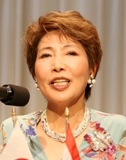��Loved by the Venus��
May 27, 2009
Ms. Noriko Tamura
Artist
 58 fusuma��sliding door��paintings of 60-meter-long at Hogon��in Temple, a minor temple of Tenryu-ji Temple in Arashiyama, Kyoto was my 50th work. As I am an oil painter, many people wonder why I came to work on fusuma paintings at the very traditional Japanese temple. It was because I was asked by a Buddhist priest to collaborate for the Temple��s reconstruction, which took place after 350 years.
58 fusuma��sliding door��paintings of 60-meter-long at Hogon��in Temple, a minor temple of Tenryu-ji Temple in Arashiyama, Kyoto was my 50th work. As I am an oil painter, many people wonder why I came to work on fusuma paintings at the very traditional Japanese temple. It was because I was asked by a Buddhist priest to collaborate for the Temple��s reconstruction, which took place after 350 years.
In 1988, when I was studying at the Central Academy of Fine Arts in Beijing, China as an oversea researcher of the Agency for Cultural Affairs, I was given a chance to paint on the 60-meter-long wall at the main lobby of Xi��an Garden Tang Hua Hotel, a joint venture between China and Japan. This painting became my very first work. A group of Japanese Buddhist priests travelling in China happened to stay at this hotel and they got interested in the painting and its painter. Among them was the priest of Hogon��in Temple, who wished to ask the painter to paint for his temple someday. This was 20 years ago.
After 15 years, when I was working on my 45th work, this priest visited me and said, ��In the Japanese tradition, females do not engage in works in temples. What is more, as you are an oil painter, I have been wondering if you could grant my request to paint fusuma of Hogon��in Temple, which will be reconstructed as a most notable Zen temple.�� I was impressed by his enthusiasm and devoted myself to the paintings for 2 years at the studio in Shibuya.
The studio, a converted apartment room, was not large enough to hold 60-meter-long canvases. I removed all the air conditioners from the wall to make room for the 2-meter-high canvases. In winter time, I had to warm my fingertips benumbed with cold. I completed the 58 paintings painted on both sides of the canvases, which became my 50th work. They were exhibited in Tokyo, Nagoya and Osaka before they were installed in the temple.
I used the quick-drying acrylic paint for this work. Traditional fusuma paintings are painted on Japanese paper, but I ventured on using the hemp cloth canvas. This combination gave the work a tint similar to mineral pigments or sumi ink.
I used the roller as a brush, a method I devised, in combination with brushes of various thicknesses. They say my works look like Japanese paintings, maybe because I work extensively with line drawing.
Red base color is quite rare for fusuma paintings, but I intentionally chose red, which is now called ��Tamura Red�� as it represents life blazing in mother nature of Arashiyama.
I depicted the magnificent mountains, rivers and wind ripples in the overall background. The gleaming sun and the moon, yellow desert and deep blue sky, birds and 33 human figures wrapped in unbleached cotton robe. Nothing else.
Faces and features of the figures do not depict any specific person, image, narrative or tale. The viewers�� imagination will project images of their own. Women, children and the old are in different postures, with a solid outline. I want the viewers from all countries and periods, to transcend time and space, liberate their minds, let their imagination and sensitivity work freely, and talk with the paintings. Hogon��in Temple is open to the public each spring and autumn, so please make a visit and see the paintings.
I painted a wall (11.5m x 9.1m) in a luxurious passenger liner ��Asuka,�� which I painted at the dockyard in Nagasaki in 1991, by using 2 scaffolds with a lifeline tied around my waist.
When I worked on the ceiling painting at Furukawa Museum in Nagoya, I was requested to make my work site open to the public. For a month and a half, I was exposed to a large crowd of people, who were looking up at me full of curiosity and eagerness. Some came every day, some stayed for long hours, and some asked me questions, which was quite an enjoyable experience for me.
I painted the 2m x 13m wall painting in 2001 at the Keiyu Hospital in Oome, to cheer the elderly in wheelchairs who mostly stay indoors. The 4m x 7m wall was painted in the Kitasato Institute Hospital in Minato-ward in 1999. By early next year, 4 wall paintings will be seen in the lobby of Red Cross Hospital in Hiroo, Shibuya.
I have lived in different countries, including India (1969-1973), China (1986), and Thailand (in Bangkok, 1995-1998). In my 20-year-career as an artist, I enjoyed being engaged in many wall paintings. It gives me a great delight to know that my works have reached the minds of the viewers and made them feel ��comforted, cheered and happy.��
I am determined to continue painting which I call ��my child��. ��Megami no zawameki (A buzz of Venus)�� is my latest ��child�� which will be exhibited at Wako Gallery in Ginza (15 October – 06 November). Information on my past work of wall paintings or future events are posted on my website ��http://tamuranoriko.yukigesho.com,�� and I would be happy if you visit my site.